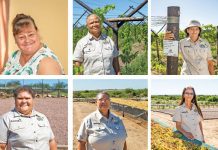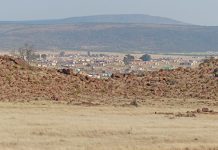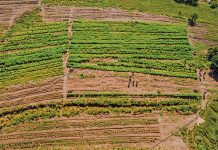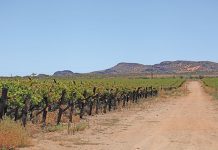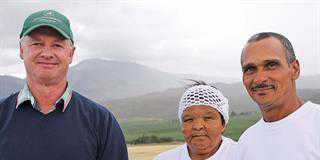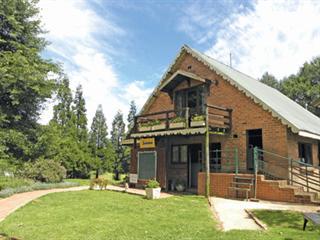
Swissland Cheese, a small enterprise that produces goat cheese, is situated in Balgowan, KwaZulu-Natal. And over the years it has done better and better. What is its secret?
According to the owner, Fran Isaac, it’s not just its cheeses but its location. This 30ha farm, with its herd of 60 snowy white Saanen milk goats, is on the highly popular Midlands Meander tourist route, and this has guaranteed a steady stream of customers. “We started up at the same time as the Midlands Meander and our business has grown along with it,” says Fran, a self-taught cheese maker.
“People have come to know us simply by word of mouth and advertising on the Meander. We sell about 80% of our product through the farm shop while 20% goes to agents in Cape Town, Durban and Gauteng.” Of course, there’s much more to Fran’s success than being on a busy tourist route. Her cheeses are mouth-watering and in constant demand, and her range offers something for everyone: Pecorino, St Maure, Isinyani, Tomini, Drakensberg, Brie-style, Chevin and cream cheese.
Fran, who devised the recipes herself through trial and error, has entered them into several competitions where they have won top prizes. “The Drakensberg, St Maure and smoked Chevin in particular always stand out,” she says proudly. Her most recent accolades are the 2011 SA Dairy Cheese Championships Award for Best White-Mould Cheese and the 2011 Eat In Award for Best Small Producer: Dairy.
Another factor boosting sales is the growing awareness of the health benefits of goat cheese. It’s easier to digest than cow cheese and has much less fat. It also has no cholesterol. “More people, especially those who are intolerant of cow’s milk, are coming into the shop specifically looking for these health benefits,” says Fran.
But Fran, like cheese makers everywhere, knows that her real success starts with her animals – and her care shows in her small herd of contented, healthy, free-roaming goats.
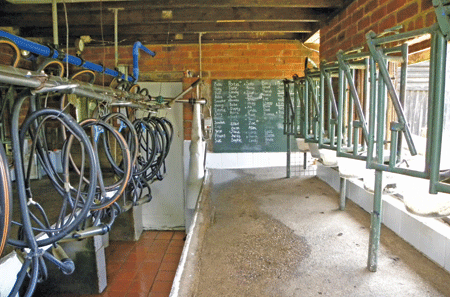
Swiss Style
Fran was given 30ha of felled timberland in 1992 by her parents, who live on the neighbouring farm. “They started farming here in 1960,” she says. “My father bought this property for the timber and we also had a few Swiss Saanen goats and made cheese as a hobby. After a while, I saw an opportunity to create a little Swiss-themed farm, since it’s high in the hills. I planted pines and conifers and built a Swiss-style chalet,” she explains.
The theme extends to all the structures on the farm – even the goat sheds are distinctly Swiss. The main shed, which is 15m x 5m and built of slatted wooden planks, stands on stilts to ensure the goats aren’t in mud in wet weather. “The goats don’t like getting wet. As soon as there’s a drop of rain they run for the shed!” says Fran. “Saanens aren’t ideally suited to this climate.
It’s hot and wet, and a lot of parasites and worms occur. On the other hand, the goats thrive in the dry winter months. But it’s not the worst climate either. If they are inoculated and have sheds to prevent them getting wet, I can keep things under control.” The sheds also help to protect the Saanen’s light skin from the sun, and keep their udders clean. Fran is extremely careful about hygiene.
The goat’s udders are wiped before milking with muslin cloth dipped in iodine, and every week the dairy equipment and vacuum line is taken apart and sterilised. “Things have to be clean,” she says. “You can’t use dirty milk to make cheese, because it fights against the cultures in the cheese and it won’t set. We have milk samples tested every month to ensure they’re clean.”
Yields
The farm has 10ha of kikuyu grazing and 2ha of irrigated ryegrass, but Fran also buys in feed. Lactating goats receive 1kg of dairy ration pellets and 1,5kg of lactating meal semi-complete a day. They can also eat as much hay and rye as they like.
“When we relied on grazing we had low milk yields of 2,5l per goat per day,” recalls Fran. “This was because the goats don’t like leaving the shed to graze when it’s drizzling. When we bought in feed, yields increased to 4l per goat.
“We’ve also installed a small three-sprinkler irrigation system on the ryegrass, so we can now rely on it as top-up grazing.” Production for 10 months of the year is about 65 000l. “The second and third year is the most productive for our Saanens.
The top performers produce a seasonal average of 4l/ day. “This fluctuates from 6l/ day at the peak of the season to about 3l/day at the end of season. At eight years of age, the average is about 3l/day,” explains Fran.
Goats don’t produce milk in June and July, when they’re heavily pregnant. During this time, Fran stocks her shelves with longer-lasting hard cheese and with soft cow’s milk cheese.
Breeding success
When selecting a breeding ewe, Fran looks for good udder formation, strong legs and a large frame. Two rams service her herd of 60 ewes. About 10% of the ewes are one year old, 80% are two to seven, and 10% are eight to 10 years old. Fran keeps 10 to 15 kids each year to replace the “old ladies” and the goats with udder problems. These go into “retirement”, where all that’s asked of them is to crop the grass on the farm!
Keeping focus
This is a small, hands-on business and Fran likes it that way. She has only five employees – two on the farm, two in the factory and one as a shop assistant. Fran admits there are “opportunities to diversify into accommodation or giving cheese-making courses”, but she prefers to focus on her famous cheeses, and keeping her standards as high as ever. For her many enthusiastic customers, this is good news indeed.
Contact Fran Isaac on 082 418 3440, or [email protected] or visit www.swisslandcheese.net. •FW


